Microsoft Fabric is finally generally available! Yaaaay! Now, when the dust settles and the initial allure goes away, the most obvious question that one might ask is – how much will Fabric cost me?
Because, yes, it’s cool to have a unified analytics solution and all Fabric’s “weapons” at your disposal, but at the end of the day, looking at the wallet is what matters most:)
So, let’s try to break down all the available options, plus explain some of the concepts that may affect your Fabric workloads in terms of pricing. First, and most important, there are TWO available pricing models with Microsoft Fabric:
1. Pay-as-you-go
This is the option that was (is) available since Fabric was announced in the public preview in May 2023. If you’re completely new to Fabric, I suggest you first read this article, where I explain all the details about the latest Microsoft SaaS solution. Once you enable Fabric workloads within your tenant, you can start using various Fabric artifacts.
Here is the pricing list of the pay-as-you-go model, as of today (November 2023) in the West Europe region:
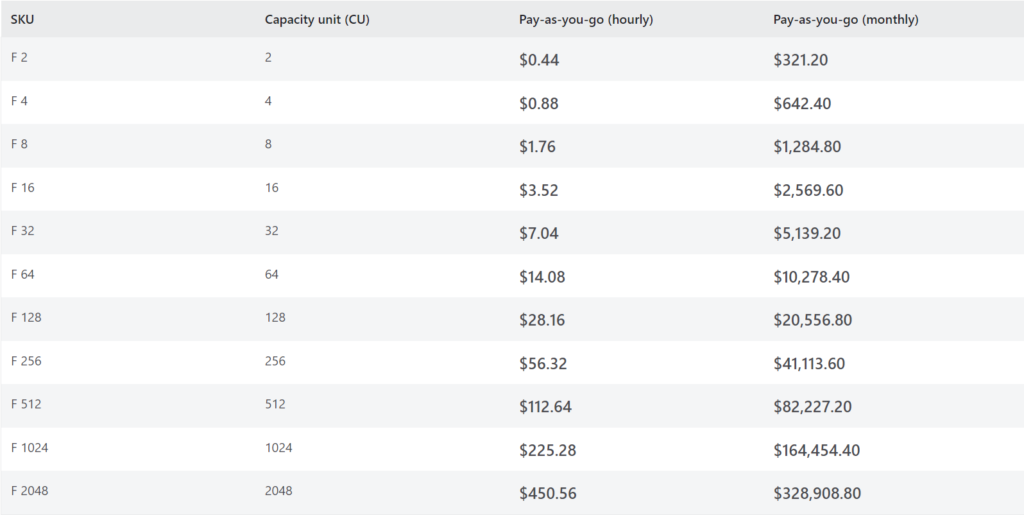
As you may see, the entry point into the Fabric world is very low – for as little as ~ $300/month, you can leverage all the Fabric goodies! Although you get “only” 2 CUs for that amount, it still may be good enough for your workloads. In my opinion, Microsoft made a very smart decision by lowering the barrier and letting basically everyone enter the Fabric “party”.
Of course, sometimes you come to the party planning to have a beer or two, but you end up being drunk after partying the whole night, and spending a lot more than you originally planned:)…But, more on that later in the article.
You can read more about the pricing models here. Since Microsoft Fabric is a SaaS solution and you don’t need to provision and maintain any kind of infrastructure (“everything just works”), these CUs will be automatically assigned to various Fabric workloads, without you having to care about it.
2. Reserved instance pricing (Capacity-reservation model)
Now, we come to the more interesting part, especially if you’re a larger shop and/or prefer to have predictable monthly costs for Fabric. As announced today at Ignite, similar to the Power BI Premium-per-capacity licensing model, you can reserve resources and “lock” the price on a monthly basis for a period of one year!
The current prices, if purchased via Azure subscription, are slightly higher (~15%) than if paying via M365 Subscription (see the current pricing for the West Europe region below). On the other hand, current F capacity-based prices are significantly lower than the Pay-as-you-go model (~40%), so that may be a good incentive to choose this model.
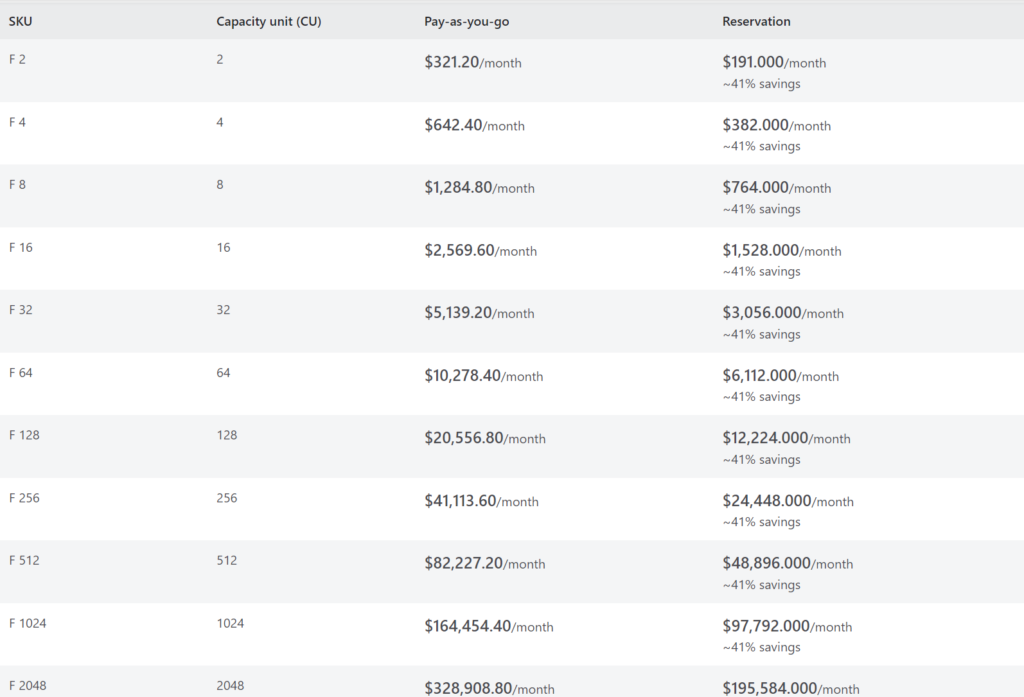
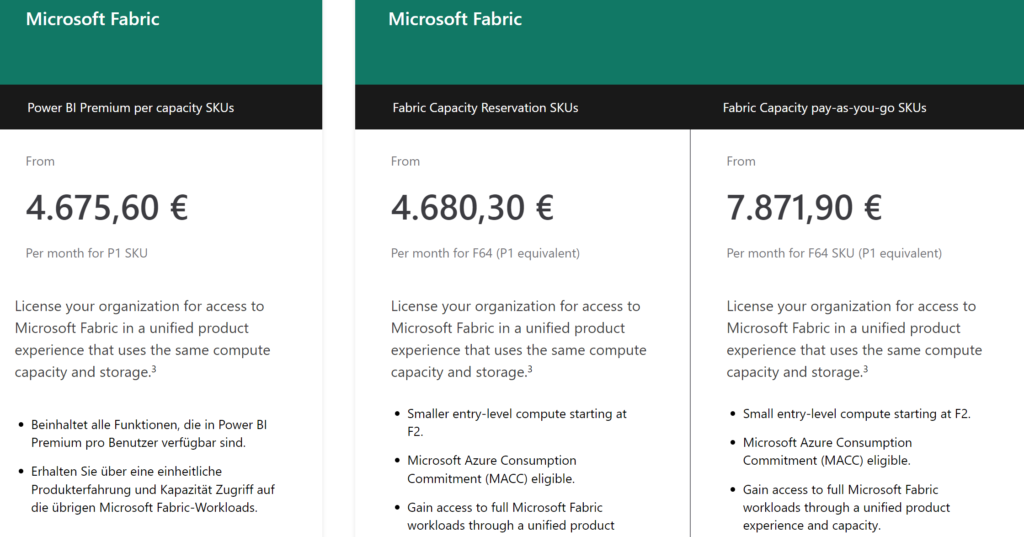
However, these prices are only for Fabric capacity usage – you will need to pay storage and networking charges in addition.
Storage costs
Same as in other modern data platform solutions (Databricks, Snowflake, etc.), in Microsoft Fabric, storage is decoupled from compute. In the paragraph above, we were talking about compute pricing, so let’s now mention the storage part.
In Fabric, all your data resides in OneLake. That’s your single storage layer, as there can be only one OneLake per tenant!

You’ll need to pay for storage on a monthly basis – currently $0.024/GB per month in the West Europe region. You should always take into account storage costs – nevertheless, if you choose the Pay-as-you-go or Reserved instance pricing model.
Things to watch out for in the Pay-as-you-go model!
Ok, I promised I’d come later to explain “partying all the night” in terms of Microsoft Fabric’s potential bill. It’s time to introduce you to concepts of bursting and smoothing, which I covered in a separate article!
Thanks to my fellow MVPs, Tristan Malherbe and Just Blindbaek, as well as Alex Barbeau and Mimoune Djouallah (Alex and Mim are not “officially” MVPs, but they are both super-knowledgeable guys) for demistyfing these concepts
Of course, you don’t necessarily need to understand all the technicalities behind these two concepts, but you should be aware of their existence and the way they work in synergy, if you don’t want to be surprised with poor performance and/or higher Azure bill!
To keep it very short here:
Bursting lets you use more power than you purchased (within the specific timeframe)! Smoothing takes care that this power is “under control” within that same timeframe. For all the remaining details, please refer to the aforementioned article on “Yin and Yang of Fabric capacity”…
In my opinion, finding the “tipping point” between bursting and smoothing, and the right balance for Fabric workloads, will be one of the biggest challenges and this is the area where potential tuning may bring some significant cost-performance optimization.
To wrap up the “Yin-Yang” story about bursting and smoothing – these concepts are only relevant to the Pay-as-you-go pricing model. When you choose the reserved instance model, costs are fixed and the worst thing that may happen is throttling, but there will be no additional costs attached to your monthly bill.
I’m currently using Power BI P SKU – What happens now?!
Nothing! You can continue using the P license the same as you were using it till now. In this article, I’ve already explained all the details and nuances between various Power BI licenses. Everything written there is still valid. You can leverage all the Fabric features with P capacities, without paying anything in addition! You just have to enable them in your tenant. With F capacities introduced, you simply get an additional option for purchasing Fabric features (through the Azure or M365 subscription). Please keep in mind that P1 (the entry-level Power BI Premium-per-capacity license) is equivalent to the F64 Fabric capacity license. This means, all <F64 SKUs still require a Power BI Pro license for consuming the Power BI content (it’s treated the same as the shared capacity in the “traditional” Power BI ecosystem). Power BI content creators, same as now, still need a Power BI Pro license.
However, there IS one important difference. Premium-per-user licensed users can’t create or share non-Power BI-related artifacts anymore!
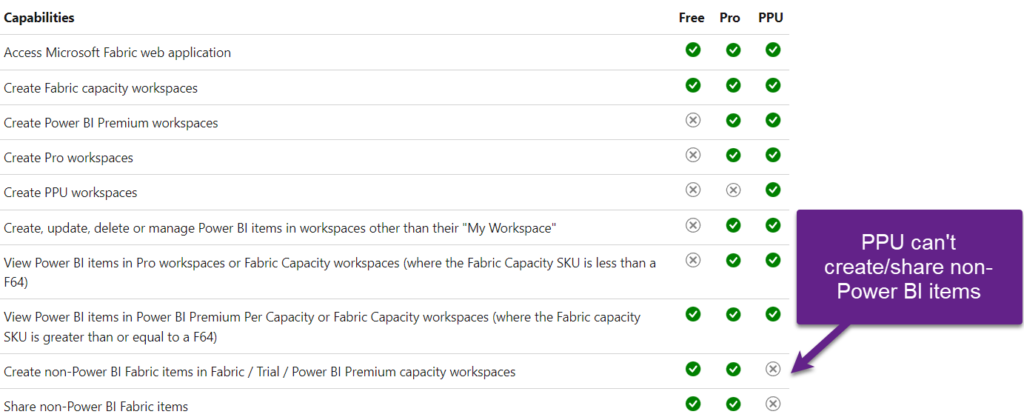
The official docs are very confusing on this (if correct at all)! For me, it’s super strange that Free/Pro license users can create Fabric content in the P workspace, whereas PPU license can’t…I’ve officially asked Microsoft to check and confirm this and I’ll update the article as soon as I get the official answer.
“We’re a small shop with ~50 Power BI users, but we want to leverage Fabric features…”
Well, I have good news for you! For as little as ~$690, you can have it! F2 reserved capacity is currently priced at ~$190, plus you need 50 Pro licenses for Power BI users (50 x $10 = $500) and for less than $700 you have all Fabric goodies (Lakehouse, Warehouse, pipelines, etc.) available! That’s an unbeatable offer if you ask me!
Previously, if you wanted to take advantage of Power BI Premium features, you would have paid for 50 Premium-per-user licenses: 50 x $20 = $1000. Now, for less money, you get Fabric items and workloads included!
Conclusion
So, the new era officially begun! Now that we know all the details about pricing, I’m sure we’ll find many use cases and develop various recommended practices for scaling Fabric-related workloads. Therefore, I’m beyond excited to see how Microsoft Fabric will evolve, and can’t wait to see it work in a real-life production environment.
Thanks for reading!
Last Updated on November 21, 2023 by Nikola



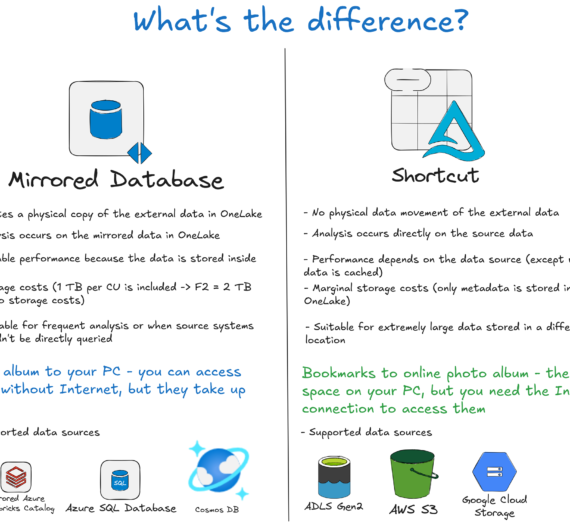

vivien
Hello Nikola,
As you said, there’s about 15% difference between a P1 on the M365 side and an F64 on the Azure side.
Isn’t this difference explained by the fact that on the P1 side, you still need a Pro or PPU licence to publish/share content, whereas on the F64 side, this is no longer necessary?
https://learn.microsoft.com/en-us/fabric/enterprise/licenses#workspace
If so, this would mean that Microsoft has smoothed out the cost of these licences, which are no longer needed on the F64 side.
What do you think about this ?
Thanks in advance for your feedback,
Vivien
Nikola
Hi Vivien,
The 15% difference is only relevant for some regions (in the example I used, such as West Europe). For some other regions, the price is almost the same for P1/F64. Just to be clear, in F64 capacity, one still needs Power BI Pro license for creating non-Fabric items (Power BI reports, etc.).
Hope this helps.
Best,
Nikola
Vivien
Hello Nikola,
Thank you very much for your feedback and explanations. So subscribing to P1 or F64 doesn’t change anything for PBI Pro or PPU licences for content producers?
However, if we use P1, there is no additional storage charge? Whereas with an F64 subscription, a storage cost per GB is charged?
Thanks in advance for your return,
Vivien
Alex Karanja
Nice breakdown of the party as always Nicola.
Scenario: I have a PowerBiEmbedded A2 sku and an app that serves upto 500 report viewers . Of these the report creators are 10 in number where as the data model creators are 5 within these 10 number (10 PPU licenses)
How do I translate this to a Fabric costing? (preferably reserved monthly predictable pricing)
ps* I am not that emotionally attached to the embedded app and can live without it if need be
Nikola
Hi Alex,
If you have 500 report viewers, and you *WANT/MUST* use Fabric features (non-Power BI items), nothing below F64 wouldn’t make sense for you, because then you’ll need a Pro license for each user consuming Power BI content…Which is 500*10 = 5000 USD/month. Whereas for the same amount you get F64 and then you can possibly scale to thousands of free Power BI content consumers (you’d still need these 10 Pro licenses for content creators). So, if you don’t need Fabric items, I’d advise sticking with A2.
Hope this helps.
Best,
Nikola
James Lees
Good article, thank you.
Whilst Fabric pricing starts cheap, it is potentially still a big jump up from Power BI for a smaller organisation with a few Power BI Pro or PPU users – let’s say you just want Gen2 dataflows and some data lake.
For a non-reserved capacity, does the charging clock tick only when a dataflow gen2 is executing, or all the time? If all the time, how would you script to disable when not in use?
Nikola
Hi James,
For Pay-as-you-go, you’re just paying for the time your Fabric items are up and running. At this moment, you can pause/resume F capacity from the Azure portal, as described here: https://learn.microsoft.com/en-us/fabric/enterprise/pause-resume
Hope this helps.
Cheers,
Nikola
James Lees
Thanks for replying! So “up and running” — does that mean actually executing? In the case of a Gen2 dataflow that is scheduled to ingest data say, does that mean the charge is based just on the 5 mins per day? Or if we don’t pause the capacity does it bill 24 hours per day?
Nikola
Hi James,
Sorry, I missed your question somehow:(…Up and running means that Fabric capacity is TURNED ON (not necessarily “doing” something specifically). Please keep in mind that in case you pause the capacity, all the Fabric workloads will be unavailable (think of Power BI report based on Direct Lake dataset, for example).
Cheers,
Nikola
David
Is the PAYG pricing always active? I.e. if I only have minimal processing to do, will PAYG only charge for that short periods of time the F2 instance is active, or is the F2 instance always active in order to run background tasks?
This matters to me, because it’s the difference between spending tens of dollars a month on personal projects, vs $300-400 a month on personal projects. I cannot justify >$3000 a year for my personal projects right now.
Nikola
Hi David,
Good question. With PAYG, you’ll be charged for all the time your Fabric capacity is TURNED ON! So, it doesn’t matter if you are doing something or not, if it’s turned on, you’ll pay for it. Please keep in mind that in case you pause the capacity, all the Fabric workloads will be unavailable (think of Power BI report based on Direct Lake dataset, for example).
Hope this helps.
Best,
Nikola
David
Thanks Nikola! It looks like I can enable/disable capacity with Logic Apps too, so I can automate that as well in order to reduce costs. That makes this a much more attractive option for personal and small-scale projects.
Which frankly is my biggest barrier to picking up the platform. I like gaining experience with platforms like this on personal projects before recommending it as a solution for clients.
Alex
Hey,
Thank you for a great post.
I am new to working with the cloud and i’m in a very small company which owns alot of data. I was employed as a DA but im doing more of engineering work now as there is no warehouse etc.
So in short, we want to set up a warehouse and for internal reporting but also to create some power BI reports in our app for external customers (peak about 3 000 users which will happpen once or twice monthly, then just a few users daily). I have came to the conclusion that we should go for Fabric, as my understanding is that we can use the F capacity for both the development work but also for embedding. Do you have any more information about this? Its very hard to understand pricing – i can’t even tell if we can manage with a f4 or f64 subscription.. are there any benchmarks you can refer to?
one specific question: If we go for say f8 capacity and need much more compute on “peak day” for our embedded report, then my understanding that bursting will do the job? right?
Jason Somwan
Dear Nikola
Since I just bought a Power BI Pro license, is it possible to use it with F2 to serve 250 users? I’d appreciate it if you could offer some solutions. Thank you in advance.
Thanks
Jason
Nikola
Hey Jason,
If you use F2, then all these 250 users will also need Power BI Pro license to consume reports. F64 is the entry point for the free license for report consumers.
Hope this helps.
Cheers,
Nikola
Denis
Hello Nikola,
I understand that the P1 capacity of a Power BI Premium license translates into a F64 capacity.
Can I use Fabric features with that license only ?
Data newbie question : what triggers the payment of a pay-as-you-go capacity or of a reserved capacity ? (around 5000€/month for a reserved F64)
Nikola
Hi Denis,
You can use Fabric features with any F SKU (starting from F2) OR with P SKU. However, there is no P SKU equivalent to F2-F32 SKUs, as the entry level P SKU is P1, which is equivalent to F64. For P SKUs, you need to explicitly enable creation of Fabric items. Also, keep in mind that P SKUs will be deprecated in the near future.
Regarding your other question about PAYG vs reserved capacity: the answer is simple – costs:)…Depending on the specific scenario, you can save a decent amount of money going one way or the other. The main difference is related to Power BI licenses, since for all F SKUs below F64, every Power BI user (both report creators and report consumers) must have Power BI Pro license (soon to cost $14/per user per month). Which means, if the company has 500 Power BI report consumers, this will cost them ca. $7000/month. In that scenario, it makes more sense to pay $5000/month for reserved F64 capacity, where report consumers don’t need Pro license.
Hope this helps.
Denis
OK many thanks,
Last candid question : once my Fabric trial has ended, can I keep using it for small projects not requiring computational speed, paying only for the Power BI Premium license ?
Nikola
Once the Trial license expires, if you want to continue using Fabric items, you MUST have either a paid Fabric license (F SKU) or Power BI Premium-per-capacity (P SKU) with Fabric enabled. Power BI Premium-per-user (PPU) license, unfortunately, doesn’t support Fabric items.
Adas
I have a question regarding DirectLake and pricing. If i have a lakehouse + semantic model with DirectLake: do I pay everytime a single user uses a report, which is connected to the Dataset which uses DirectLake? For instance if I have 200-300 Report users, using 10-15 Datasets that use DirectLake. Do I pay all the time per query? And how do I estimate the CPU usage?! It sounds nearly impossible to me.. Thanks in advance!
Nikola
Hi Adas,
No, you are not paying for 200-300 users using 10-15 datasets. Simply said, you are paying for number of CUs and the time you are using them (when I say using, it’s not necessarily the “active” usage, but having them ready and available). CU usage is very hard to predict without thorough testing, and depending on your workloads.
Hope this helps.
Best,
Nikola
Max Wikström
Thanks Nikola for a great summary of Fabric pricing!
Did you get any clarity on the possibility for PPU users to create non Power BI objects?
Nikola
Hi Max,
Unfortunately, haven’t heard back from Microsoft regarding the PPU…Thanks for the heads up, I’ll send a reminder now:)